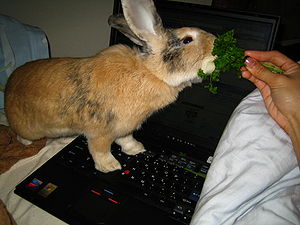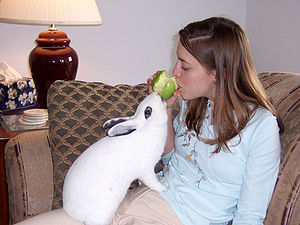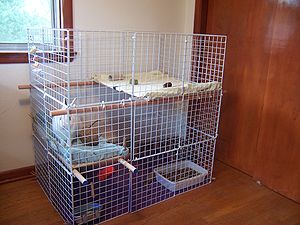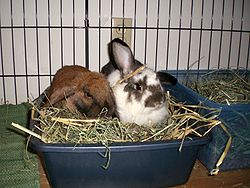
House rabbit
Encyclopedia

Domestic rabbit
A domestic rabbit, or more commonly known as simply the rabbit, is any of the several varieties of European rabbit that have been domesticated....
kept for companionship that lives inside its owner's home. House rabbits can be trained to use a litter box, and can live as long as 8-10 years when properly cared for.
Keeping a rabbit as a house companion was articulated by Sandy Crook in her 1981 book Your French Lop. In 1983, Crook was a featured lecturer to the 35,000 attendees at the American Family Pet Show in Anaheim, California where she presented her personal experiences of living with her indoor rabbit as evidence of a human-rabbit bond. Throughout the 1980s it became more common to litter-box train a rabbit indoors.
In 1988, the House Rabbit Society was founded in the United States as an educational and activist organization with the general philosophy that domestic rabbits should be neutered or spayed and live in human housing".
Sources of house rabbits
There are many humane societiesHumane Society
A humane society may be a group that aims to stop human or animal suffering due to cruelty or other reasons, although in many countries, it is now used mostly for societies for the prevention of cruelty to animals...
, animal shelter
Animal shelter
An animal shelter is a facility that houses homeless, lost, or abandoned animals; primarily a large variety of dogs and cats.Parrots, for example, are the third most common pet owned by people...
s, and rescue group
Rescue group
An animal rescue group or animal rescue organization is dedicated to pet adoption. These groups take unwanted, abandoned, abused, or stray pets and attempt to find suitable new homes for them...
s, that have rabbits available for adoption
Pet adoption
Pet adoption usually refers to the process of taking guardianship of and responsibility for a pet that a previous owner has abandoned or released to a shelter or rescue organization...
. Typically, animal shelters charge the smallest fee. House rabbits are often purchased from pet stores, private breeders, and fanciers. House rabbits may be acquired as either housebroken or not housebroken.
Rabbits are often spayed or neutered for health and behavior benefits or to reduce the chance of unwanted offspring. Starting at adolescence
Adolescence
Adolescence is a transitional stage of physical and mental human development generally occurring between puberty and legal adulthood , but largely characterized as beginning and ending with the teenage stage...
, rabbits that are not spayed or neutered may begin displaying territorial marking, which can frustrate efforts to litter train as well as damage household items.
Socialization

However, house rabbits can live alone if lots of attention is paid to them by the owner.
Some house rabbit keepers teach their animals to follow voice commands such as coming when called by name.
Many house rabbits have successfully cohabited with the family dog or cat. Leaving dog
Dog
The domestic dog is a domesticated form of the gray wolf, a member of the Canidae family of the order Carnivora. The term is used for both feral and pet varieties. The dog may have been the first animal to be domesticated, and has been the most widely kept working, hunting, and companion animal in...
s and cat
Cat
The cat , also known as the domestic cat or housecat to distinguish it from other felids and felines, is a small, usually furry, domesticated, carnivorous mammal that is valued by humans for its companionship and for its ability to hunt vermin and household pests...
s alone with rabbits has been dangerous in some cases, as animals with aggressive predatory instinct
Instinct
Instinct or innate behavior is the inherent inclination of a living organism toward a particular behavior.The simplest example of an instinctive behavior is a fixed action pattern, in which a very short to medium length sequence of actions, without variation, are carried out in response to a...
s or overenthusiastic play can lead to the dog or cat attacking the rabbit spontaneously. The choice to gradually introduce the different species is usually made with caution and after consideration of known temperaments of the animals involved. .
Rabbits have been successfully housed with guinea pigs; however, there are risks in doing so that may make the practice inadvisable. Guinea pigs are susceptible to respiratory disease from bacteria that rabbits carry. Additionally, rabbits may harm small rodents sharing their territory.
House rabbit care


House rabbits are usually fed grass hay.
Pellets made from timothy grass may supplement a house rabbit's diet. This differs from commercial rabbits, where pellets often account for a much larger portion of the diet.
Living in a house shelters a rabbit from possible dangers such as predators and pesticide
Pesticide
Pesticides are substances or mixture of substances intended for preventing, destroying, repelling or mitigating any pest.A pesticide may be a chemical unicycle, biological agent , antimicrobial, disinfectant or device used against any pest...
s, but it has its own hazards if the owner is not diligent. To prevent electrocution
Electric shock
Electric Shock of a body with any source of electricity that causes a sufficient current through the skin, muscles or hair. Typically, the expression is used to denote an unwanted exposure to electricity, hence the effects are considered undesirable....
, house rabbit owners hide electrical cords or cover them with flexible clear tubing. Rabbits' ingestion of papers, fabric, and carpet
Carpet
A carpet is a textile floor covering consisting of an upper layer of "pile" attached to a backing. The pile is generally either made from wool or a manmade fibre such as polypropylene,nylon or polyester and usually consists of twisted tufts which are often heat-treated to maintain their...
may cause gastrointestinal blockages, and their chewing may damage their owners' possessions and homes when proper precautions are not taken.
In most regions, house rabbits do not require vaccination
Vaccination
Vaccination is the administration of antigenic material to stimulate the immune system of an individual to develop adaptive immunity to a disease. Vaccines can prevent or ameliorate the effects of infection by many pathogens...
; however, vaccines are prophylactic against myxomatosis
Myxomatosis
Myxomatosis is a disease that affects rabbits and is caused by the Myxoma virus. It was first observed in Uruguay in laboratory rabbits in the late 19th century. It was introduced into Australia in 1950 in an attempt to control the rabbit population...
and rabbit hemorrhagic disease where these vaccines are legally premitted. While tularemia
Tularemia
Tularemia is a serious infectious disease caused by the bacterium Francisella tularensis. A Gram-negative, nonmotile coccobacillus, the bacterium has several subspecies with varying degrees of virulence. The most important of those is F...
is a zoonotic disease of concern, there is no vaccine currently available - instead good hygiene is the best preventative. In the United States these diseases are extremely rare or nonexistent and of little concern to pet rabbit owners. There have been no reported cases of rabbit hemorrhagic disease (VHD) in the United States in over six years.
House rabbit organizations recommend that house rabbits be neutered
Neutering
Neutering, from the Latin neuter , is the removal of an animal's reproductive organ, either all of it or a considerably large part. The process is often used in reference to males whereas spaying is often reserved for females. Colloquially, both terms are often referred to as fixing...
or spayed. Health advantages of neutering and spaying include a reduced risk of ovarian
Ovarian cancer
Ovarian cancer is a cancerous growth arising from the ovary. Symptoms are frequently very subtle early on and may include: bloating, pelvic pain, difficulty eating and frequent urination, and are easily confused with other illnesses....
and uterine cancer
Uterine cancer
The term uterine cancer may refer to any of several different types of cancer which occur in the uterus, namely:*Uterine sarcomas: sarcomas of the myometrium, or muscular layer of the uterus, are most commonly leiomyosarcomas.*Endometrial cancer:...
and endometritis
Endometritis
Endometritis refers to inflammation of the endometrium, the inner lining of the uterus. Pathologists have traditionally classified endometritis as either acute or chronic: acute endometritis is characterized by the presence of microabscesses or neutrophils within the endometrial glands, while...
in females. Neutering and spaying house rabbits also reduces territorial marking in males, and aggression toward other rabbits.
Unlike a cat
Cat
The cat , also known as the domestic cat or housecat to distinguish it from other felids and felines, is a small, usually furry, domesticated, carnivorous mammal that is valued by humans for its companionship and for its ability to hunt vermin and household pests...
, a rabbit cannot be declawed
Onychectomy
Onychectomy, popularly known as declawing, is an operation to surgically remove an animal's claws by means of amputating all or part of the distal phalanx, or end bones, of the animal's toes. It is performed most often on household cats, though occasionally on other animals such as circus lions or...
. Lacking pads on the bottoms of its feet, a rabbit requires its claws for balance. Removing its claws will render it unable to stand. Rabbits with access to rough surfaces will naturally keep their claws worn down to a certain extent when running, but most pet rabbits normally require their claws to be clipped regularly.
House rabbits may need regular brushing, especially if they are of a long-haired variety. Due to the rabbit's biological incapability to vomit, removing excess fur prevents intestinal blocking and fatal choking that can be caused by hair ingested during self-grooming.
Spaying female rabbits greatly reduces the risk of cancers of the breast, uterus, and ovaries.
External links
- http://www.rabbit.org/

